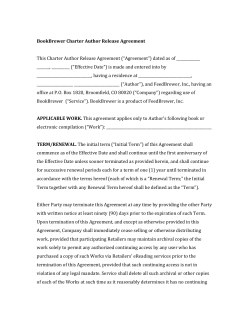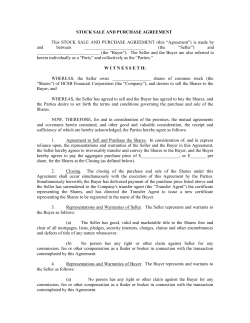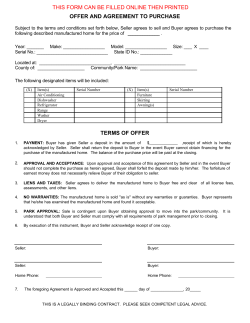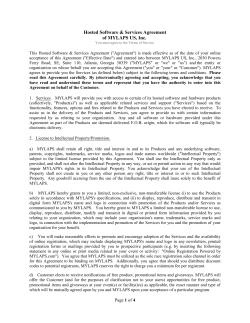
Rebuilding Customer Loyalty with Extended Warranties EXECUTIVE SUMMARY Situation:
Rebuilding Customer Loyalty with Extended Warranties EX EC UTIVE SUMMARY Situation: Consumer electronics and appliance retailers compete in a highly fragmented marketplace and contend with compressed margins. Increased competition, rising commodity prices and a lackluster economic recovery continue to pressure appliance and consumer electronic profit margins. As retailers contend with these economic realities, they also must deal with rapidly changing consumer behaviors. Unlike previous economic recoveries, retailers cannot depend on loyal customers returning to their store in today’s fragmented marketplace. An Assurant Solutions’ Consumer Profile and Interest Study The Assurant Solutions’ Consumer Profile and Interest Study was conducted within a two-week period in the late fall of 2010. Online interviews were completed among 1,018 respondents who own either a cell phone, laptop, notebook or desktop computer, flat panel or high definition television, and subscribe to either a landline, cellular, Internet or cable service. The term “extended warranty” is a broad term that is commonly used to describe extended service and extended protection plans. Consumers remain skittish about the economic recovery. As a result, many have embraced a new frugality that continues to depress consumer electronic sales. Concurrently, appliance purchases have suffered due to the ongoing housing crisis. Despite the weak sales environment, consumer expectations are growing. With access to more product information than ever before, shoppers are jumping online and on their mobile phones to find coupons, gather the latest reviews and comparison shop. The increased online consumer search efforts as well as the emergence of online retailers operating in this space have made the competitive marketplace even more challenging. Solution: Extended warranties can lead to improved customer loyalty and improved sales. Extended warranties continue to evolve to meet the needs of today’s demanding consumer. Whether it is providing customer services on demand or reducing the anxiety caused by technology churn, these product coverage options provide shoppers financial protection and peace of mind. For retailers, a low-cost marketing plan for extended warranties (also known as extended service plans) can help improve customer retention and loyalty. While communicating the benefits of extended warranties to shoppers, retailers can seize the opportunity to engage today’s appliance and consumer electronics buyer in discussion. With more and more shoppers doing a significant amount of research prior to purchasing, this discussion provides an opening to satisfy the consumer’s need for information. While explaining the benefits of an extended warranty plan the retailer can also educate the buyer about available products and services. Result: Customers who purchase an extended service contract are more likely to be loyal customers. Assurant Solutions’ Consumer Profile and Interest Study found that those who purchase extended warranties are more than twice as likely to recommend the retail store where they shop to others. Customer endorsements help retailers differentiate themselves from their peers, leading to improved customer satisfaction and repeat customers. This is critical in today’s environment where a shopper’s praise or complaint can go viral at an alarming speed and have a significant impact on a business’s bottom line. T H E M A R G IN SQU EEZE compressed, retailers are reluctant to cut even further. Concurrently, shoppers are unwilling to accept price increases. As a result, the short-term sales outlook remains weak despite the launch of innovative and appealing new technology. Many retailers today find their profit margins being squeezed by a number of economic factors out of their control. Spiking oil prices, caused by ongoing instability in the Middle East, “Retailers dedicated to electronic are driving up raw material costs. product sales have been seeing The falling dollar is increasing import soft sales of televisions and costs. Rising inflation is eating into computer supplies due to less disposable income. And persistent high popular innovation and more unemployment continues to drag down competition from online sales and consumer confidence. big box discount chains. Demand weakness is widespread.”1 Appliance and electronic retailers are particularly vulnerable to the macro environment as rising prices for necessities dampen consumer enthusiasm and reduce discretionary purchases. The consumer psyche remains financially and emotionally drained from the economic roller coaster and sluggish recovery. With a wary eye toward the future, many shoppers hold onto their gadgets for longer periods of time and defer unnecessary purchases. THE SHO PP ING E VO LUTIO N Compounding retailers’ woes is the evolution of consumer shopping behavior. Many have adopted a frugality that reflects a new financial consciousness. Consumers are delaying making new purchases. People are holding onto appliances and gadgets for longer than ever before. Studies indicate more people also are repairing rather than replacing malfunctioning appliances and consumer electronics.2 Despite a modest uptick in overall consumer spending recently, sales for electronics and appliances in today’s fractured marketplace have yet to rebound. Traditionally, retailers spurred consumer spending by slashing prices. While this has led to increased unit sales in the past, lower prices also squeezed margins and reduced top line revenue. With margins already K. Talley , “ Japan’s Crisis Creates Uncertainty For Electronics Retailers,” Dow Jones Newswires, March 17, 2011, <http://www.foxbusiness.com/industries/2011/03/17/japans-crisis-creates-uncertainty-electronics-retailers> 1 M. Richtel, “Consumers Hold On to Products Longer,” The New York Times, Feb. 26, 2011, p. B1. 2 2 T H E SH O PPIN G EVOL U T ION (c on t.) Another significant influence on shoppers’ behavior is the shortened life span of the latest in vogue technology. HD DVD market after a contentious battle with Sony and its Blue-ray disc player. Toshiba had sold more than a million HD DVD players and had been the moving force beyond the highdensity optical disc format before discontinuing sales in 2008. The so-called DVD War came to a close after more than five years when content manufacturers and key retailers determined one standard was needed to encourage consumers to move from the standard DVD format to highdefinition DVD. Many early adopters have been burned by rushing out to get the first version of the latest gadget only to face a shortened product cycle that results in early obsolescence. At the time, Warner Bros. Entertainment President Kevin Tsujihara said, “The two format landscape has led to consumer confusion and indifference to high definition, which has kept the technology from reaching mass adoption and becoming the important revenue stream that it can be for the industry.”3 While that is the price many techno-addicts are willing to pay, the accelerating pace of technology is leaving many other consumers paralyzed by myriad choices and uncertainty about when to jump in with their dollars. Others are simply waiting on the sidelines knowing a better, less expensive version will be rolled out in the near future. This current consumer climate also creates an atmosphere that heightens consumer demand for information about the products and goods they are considering. Retail sales are being directly affected by online search. Delayed purchases, confusion about products and fear of obsolescence can quickly erode customer satisfaction and brand loyalty. Such was the case when Toshiba was forced to exit the 12 34 Today, the typical electronic purchase process includes the following steps: Conduct online research through retailer and manufacturer websites as well as product evaluation feedback provided by sites such as Consumer Reports and Amazon. Make a decision about what and where to buy (online or in a “brick and mortar” establishment). Find the product that best matches the research decision. Make the purchase. Timewarner, “Warner Bros. Entertainment to Release Its High-Definition DVD titles exclusively in the Blu-Ray Format Beginning Later this Year,” Jan. 4, 2008, < http://www2.warnerbros.com/web/corpcomm/press_release.jsp?id=Bluray DiscFormatRelease>. 3 3 T H E SH O PPIN G EVOL U T ION (c on t.) This differs dramatically from just a generation ago. The shopping evolution continues. The hunt for the best bargain, a quality product and superior customer service is now taking place via the Internet and over mobile phones. appliances and other purchases.” The effect of the increased number of shopping outlets online has eroded consumer’s loyalty to their retail brands. An Assurant Solutions’ Consumer Profile E-tailing group, “PowerReviews’ 2010 and Interest Study conducted last year Social Shopping Study” found that 50 points to a way for retailers to strengthen percent of those surveyed reported the bond with their customers: extended warranties. The extended warranties conducting “research online for at least half of the purchases made.” alleviate common concerns consumers 4 have when making purchases. According to the study, the priority for customers The report also found that most people are reading customer reviews before making a decision to buy. Increasingly, they also are using their mobile phones to shop as well as conduct product research and compare prices. A study by Oracle, “Mobile Trends: Consumer Views of Mobile Shopping and Mobile Service Providers,” reported that shoppers are “starting to use their mobile devices to comparison shop, seek product ratings and reviews, and to search for coupons.” The study also found that retail customers are even using their mobile phones while walking through the store aisles in the quest for product information, other customers’ feedback and a better buy elsewhere.5 who buy extended warranties is to eliminate the future cost of repairs. Consumers are looking to protect what has become a financial investment for them. The study found that consumers’ interest in extended warranties directly addresses their financial worries by protecting their investment in the event that their purchase is damaged or broken. The extended warranties also allow them to hold onto their technology devices longer. By meeting these needs, retailers can strengthen their relationship with their customers. At the same time, they can help their bottom line. This instant access to information is allowing consumers to cross multiple channels in search of their purchases. According to a 2008 North American Technolographics Marketing and Mobile Internet Online Survey, “66 percent of shoppers moved from web to store, store to web or web to phone for consumer electronics, home According to Warranty Week, sales of extended warranties reached $34.5 billion in gross premiums paid last year.6 That number is only expected to grow as products become even more technologically sophisticated. PowerReviews, “2010 Social Shopping Study Reveals Changes in Consumers’ Online Shopping Habits and Usage of Customer Reviews,” May 3, 2010, < http://www.businesswire.com/news/home/20100503005110/en/2010-Social-ShoppingStudy-Reveals-Consumers%E2%80%99-Online>. 4 Oracle, “Mobile Trends: Consumer Views of Mobile Shopping and Mobile Service Providers,” March 22, 2011, < http://www.oracle.com/us/corporate/press/346256 >. 5 Eric Arnum, Warranty Week, May 2011. 6 4 OP P ORT UN IT IES TO B U IL D C USTO ME R LO YALTY WI T H P R OT EC T ION PL AN S AND SE RVICE S Retailers can help consumers navigate this cluttered information landscape and assuage their fears about making a purchase, according to the Assurant Solutions’ Consumer Profile and Interest Study. The study found that extended warranties were essential to customer loyalty. Thirty-one percent of those surveyed were more likely to promote and revisit a retail establishment if they had already owned an extended service protection plan. Word-ofmouth recommendations are critical in today’s marketplace where consumers rely on peers for reviews about products. Consumers’ online research presents retailers with a unique opportunity to educate consumers and drive sales of products and their corresponding extended warranties. According to the Nour Group’s Social Media Analysis conducted on behalf of Assurant, retailers can drive online and offline sales by putting themselves in the path of the customers search. The study identified four typical shopper behavioral profiles and their online search patterns in making purchase decisions. The Educated Buyer: Examines the facts found through online product search, completes a “need search” for pro and con comments in blogs and forums and is a forum reader. Beyond mainstream consumer electronics purchasers, early adopters also are a strong potential target market for extended warranties and a strong voice. Because they are always first in line to pick up a product, early adopters understand that their latest gadget may malfunction and have a shorter life span than the versions that follow. They also are willing to pay a premium to be at the head of technological curve and enjoy sharing their passions about devices. Similarly, early adopters who are loyal to their retailer will evangelize on behalf of the store. Discount Buyer: Makes decision based on price, not brand. Motivated by discounts, this shopper reviews product pages, other consumer reviews, scam checks, and blogs and forums to validate the price of a product. Fear, Uncertainty and Doubt Buyer: A cautious buyer who seeks out like-minded people’s opinions. This shopper is likely to do online review searches, like-minded forums and look toward blogs and product webpages for validation. The top five reasons consumers cited for buying an extended warranty were: 1. Protection against cost of unexpected repair. Past Buyer: 2. Protection against product failure. A consumer motivated by positive past experience who is willing to promote protection plans. These buyers look to manufacturer forums, general product forums, blogs and product webpages for validation and contributions. 3. So I don’t have to worry. 4. Protection on high cost of original. 5. Issues with products breaking down in the past. 5 E NH A N C IN G L IFET IM E C U STO ME R VALUE As the appliances and consumer electronics have become more sophisticated they also have become more difficult to self-repair. Product owners rely on extended service plans in the event that there is a problem with an item after the manufacturer’s warranty expires. Evolving customer needs has led to significant innovation as the industry works to meet the evolving needs of its customers. A 2010 study conducted by market research company Parks Associates predicted that the industry will approach $5 billion by 2014 with half of that generated by remote technical support services.7 Customers increasingly expect to receive virtual technical support To respond to those needs, new extended warranty products help customers get their product repaired faster or even remotely. Computer owners fighting off a virus or looking at a blue screen want help fast so some extended warranties now offer remote PC support that can help address malware and software issues. Such programs also may offer on-site repair and installation services for computers, TVs and other home appliances. on-demand. As a result, extended warranties on PCs now typically provide customers 24/7 tech support, remote diagnostics, product installation, and online data backup coverage. Consumers need for service on demand extends beyond PCs to other home electronics as In addition, retailers can now offer their customers an electronic gift card (eGift Card) to fund a replacement item if a product covered by an extended service contract failed and could not be repaired. This simplifies the process for customers and eliminates the frustration of having to wait for the check in the mail. Instead, customers can simply print an e-mail and bring it into the store or redeem their eGift Card online. well, increasingly making such product offerings a requirement for those that want to remain competitive in the marketplace. The increasing need for instant access and assistance is driving “the growth of consumer-oriented technical support services.” Park Associates, “Consumer Demand for Remote Services Helps Boost Tech Support to $5 Billion by 2014,” July 20, 2011, < http://www.parksassociates.com/blog/article/consumer-demand--technical-innovations-to-push-u-s--revenues-forremote-technical-support-services-to--2-6-billion-by-2013>. 7 6 E NH A N C IN G L IFET IM E C U STO ME R VALUE Another problem that extended warranties can help consumers address is the fast pace of technology churn that results in new generations of electronics being rolled out only months after the latest version has hit the shelves. Protection plans that offer a tech refresh option allow consumers to purchase a product and then trade it in for the latest model. Such plans alleviate shopper stress in making purchasing decisions and temper early adopters’ buyer’s remorse after they realize that a new and improved version of their new gadget will be rolled out in just a few short months. Combined with traditional service protection, tech refresh provides users with the assurance that their purchase is safe from both equipment failure and obsolescence. This is critical for all consumers who must contend with a dizzying array of product choices. Getting such protection plans in the hands of customers enhances lifetime customer value and improves customer retention. Improved store loyalty will lead to increase sales of the latest gizmo, gadget or appliance and improve a retailers’ bottom line. 7 (c on t.) Assurant Solutions businesses develop, underwrite, market and administer specialty insurance, extended service contracts and other risk management solutions through collaborative relationships with leading financial institutions, retailers, automobile dealers, funeral homes, manufacturers, wireless carriers and other entities. With operations in 25 locations, including executive offices in Atlanta, Assurant Solutions serves clients and their customers in 12 countries throughout North America, the Caribbean, Latin America, Europe and Asia. Assurant Solutions is part of Assurant, a premier provider of specialized insurance products and related services in North America and select worldwide markets. Its four key businesses — Assurant Solutions, Assurant Specialty Property, Assurant Health and Assurant Employee Benefits — partner with clients who are leaders in their industries and build leadership positions in a number of specialty insurance market segments in the United States and selected international markets. A publicly held company, Assurant is traded on the New York Stock Exchange under the symbol AIZ. With approximately $US26 billion in assets at year-end 2010 and $US8 billion in annual revenue, Assurant currently has a market capitalization of about $US4.2 billion. In 2011, Assurant was ranked No. 285 on the Fortune 500 list of the largest publicly traded companies in the United States and No. 1123 on the Forbes Global 2000, a ranking of the top 2,000 companies in the world. Assurant is a component of the S&P 500 stock market index. A25408 2011 rm 082511 © Assurant Solutions 2011
© Copyright 2025





















